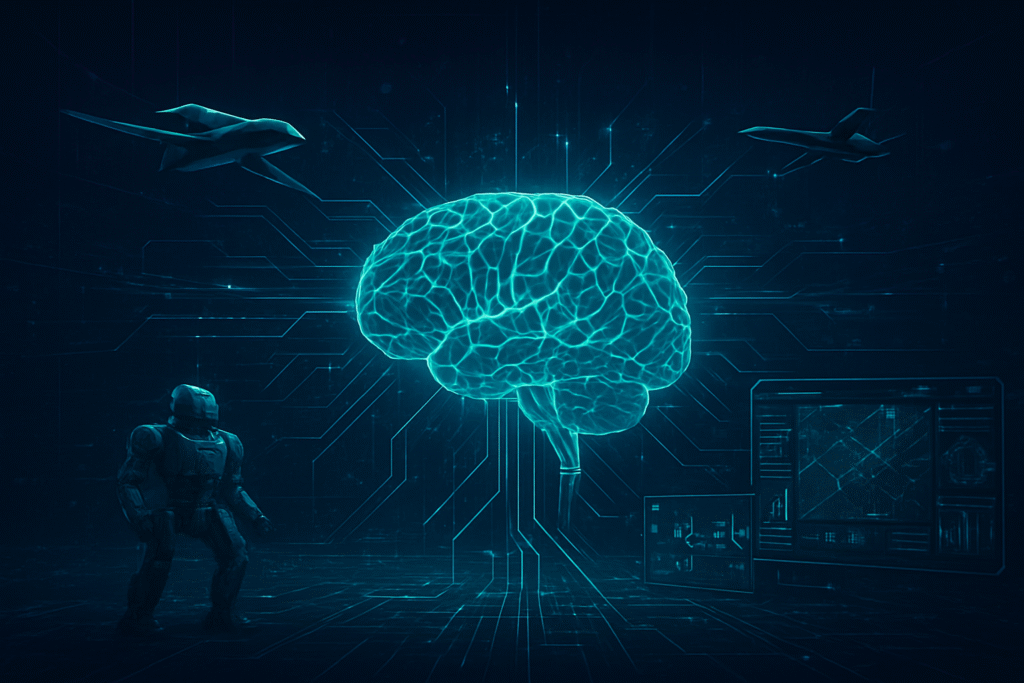
The integration of Artificial Intelligence (AI) into military technology is no longer a futuristic concept but an immediate and transformative reality, rapidly redefining global defense strategies. Nations worldwide are investing heavily, recognizing AI's capacity to revolutionize operations by enhancing efficiency, accelerating decision-making, and mitigating risks to human personnel. This technological leap promises a new era of military capability, from autonomous systems conducting reconnaissance to sophisticated algorithms predicting threats with remarkable accuracy.
Specific applications of AI are already reshaping modern defense. Autonomous drones, unmanned aerial vehicles (UAVs), and ground robots are undertaking dangerous missions, including surveillance, mine detection, and logistics, thereby reducing the exposure of human soldiers to hazardous environments. AI-powered intelligence analysis systems process vast quantities of data from diverse sources like satellites and sensors, providing real-time situational awareness and enabling more precise target identification. Furthermore, AI significantly bolsters cybersecurity by monitoring networks for unusual patterns, detecting threats, and proactively defending against cyberattacks. Beyond the front lines, AI optimizes military logistics and supply chains, predicts equipment failures through predictive maintenance, and creates highly realistic training simulations for personnel. This immediate integration of AI is not merely an enhancement but a fundamental shift, allowing militaries to operate with unprecedented speed and precision.
Technical Advancements and Ethical Crossroads
Technical advancements in military AI are rapidly transforming defense capabilities, moving beyond rudimentary automation to sophisticated, self-learning systems. Key advancements include autonomous weapon systems (AWS), particularly AI-powered drones and drone swarms, which can perform surveillance, reconnaissance, and targeted strikes with minimal human input. These systems leverage machine learning algorithms and advanced sensors for real-time environmental analysis, threat identification, and rapid decision-making, significantly reducing risks to human personnel. For instance, AI-driven drones have demonstrated capabilities to autonomously identify targets and engage threats with high precision, improving speed and accuracy compared to manually controlled systems. Beyond direct combat, AI enhances intelligence, surveillance, and reconnaissance (ISR) by processing massive volumes of sensor data, including satellite and drone imagery, to detect patterns, anomalies, and hidden threats far faster than human analysts. This capability provides superior situational awareness and enables quicker responses to emerging threats. AI is also revolutionizing military logistics through predictive analytics for supply chain management, autonomous vehicles for transport, and robotic systems for tasks like loading and unloading, thereby optimizing routes and reducing downtime.
These AI systems differ significantly from previous military technologies by shifting from pre-programmed, rules-based automation to adaptive, data-driven intelligence. Traditional systems often relied on human operators for every critical decision, from target identification to engagement. In contrast, modern military AI, powered by machine learning and deep learning, can learn and improve by processing vast datasets, making predictions, and even generating new training materials. For example, generative AI can create intricate combat simulations and realistic communications for naval wargaming, allowing for comprehensive training and strategic decision-making that would be impractical with traditional methods. In cybersecurity, AI systems analyze patterns of cyberattacks and form protective strategies, detecting malware behaviors and predicting future attacks much faster than human-led efforts. AI-powered decision support systems (DSS) can analyze real-time battlefield data, weather conditions, and enemy intelligence to suggest strategies and optimize troop movements, accelerating decision-making in complex environments. This level of autonomy and data processing capability fundamentally changes the operational tempo and scope, enabling actions that were previously impossible or highly resource-intensive for human-only forces.
The rapid integration of AI into military technology has sparked considerable ethical considerations and strong reactions from the AI research community and industry experts. A primary concern revolves around lethal autonomous weapon systems (LAWS), often colloquially termed "killer robots," which can identify and engage targets without human intervention. Many experts and human rights groups argue that delegating life-or-death decisions to machines undermines human dignity and creates an "accountability gap" for potential errors or harm to civilians. There are fears that AI systems may not accurately discriminate between combatants and non-combatants or appropriately assess proportionality, leading to increased collateral damage. Furthermore, biases embedded in AI training data can be unintentionally perpetuated or amplified, leading to unfair or unethical outcomes in military operations. Initial reactions from the AI community include widespread worry about an AI arms race, with some experts predicting catastrophic outcomes, potentially leading to "human extinction" if AI in military applications gets out of hand. Organizations like the Global Commission on Responsible AI in the Military Domain (GC REAIM) advocate for a "responsibility by design" approach, integrating ethics and legal compliance throughout the AI lifecycle, and establishing critical "red lines," such as prohibiting AI from autonomously selecting and engaging targets and preventing its integration into nuclear decision-making.
The Shifting Sands: How Military AI Impacts Tech Giants and Startups
The integration of Artificial Intelligence (AI) into military technology is profoundly reshaping the landscape for AI companies, tech giants, and startups, creating new opportunities, competitive dynamics, and ethical considerations. The defense sector's increasing demand for advanced AI solutions, driven by geopolitical tensions and a push for technological superiority, has led to a significant pivot among many tech entities that once shied away from military contracts.
A diverse array of companies, from established tech giants to innovative startups, are benefiting from the surge in military AI adoption:
-
Tech Giants:
- Microsoft (NASDAQ: MSFT) has secured substantial cooperation agreements with the U.S. military, including a 10-year deal worth $21.8 billion for over 120,000 HoloLens augmented reality products and cloud computing services.
- Google (NASDAQ: GOOGL) has reversed its stance on military AI development and is now actively participating in technological collaborations with the U.S. military, including its Workspace platform and cloud services, and has received contracts up to $200 million for enhancing AI capabilities within the Department of Defense.
- Meta (NASDAQ: META) is partnering with defense startup Anduril to develop AI-powered combat goggles for soldiers, utilizing Meta's Llama AI model.
- Amazon (NASDAQ: AMZN) is a key participant in cloud services for the Pentagon.
- OpenAI, initially with policies against military use, revised them in January 2024 to permit "national security use cases that align with our mission." They have since won a $200 million contract to provide generative AI tools to the Pentagon.
- Palantir Technologies (NYSE: PLTR) is a significant beneficiary, known for its data integration, algorithms, and AI use in modern warfare, including precision targeting. Its stock has soared, and it's seen as an essential partner in modern warfare capabilities, with contracts like a $250 million AI Service agreement.
- Anthropic and xAI have also secured contracts with the Pentagon, valued at up to $200 million each.
- Oracle (NYSE: ORCL) is another recipient of revised Pentagon cloud services deals.
- IBM (NYSE: IBM) contributes to government biometric databases and is one of the top industry leaders in military AI.
-
Traditional Defense Contractors:
- Lockheed Martin (NYSE: LMT) is evolving to embed AI and autonomous capabilities into its platforms like the F-35 Lightning II jet.
- Northrop Grumman (NYSE: NOC) works on autonomous systems like the Global Hawk and MQ-4C Triton.
- RTX Corporation (NYSE: RTX) has major interests in AI for aircraft engines, air defenses, and drones.
- BAE Systems plc (LSE: BAE) is identified as a market leader in the AI in military sector.
- L3Harris Technologies, Inc. (NYSE: LHX) was selected by the Department of Defense to develop AI and machine learning systems for intelligence, surveillance, and reconnaissance.
-
Startups Specializing in Defense AI:
- Anduril Industries rapidly gained traction with major DoD contracts, developing AI-enabled drones and collaborating with Meta.
- Shield AI is scaling battlefield drone intelligence.
- Helsing is a European software AI startup developing AI software to improve battlefield decision-making.
- EdgeRunner AI focuses on "Generative AI at the Edge" for military applications.
- DEFCON AI leverages AI for next-generation modeling, simulation, and analysis tools.
- Applied Intuition uses AI to enhance the development, testing, and deployment of autonomous systems for defense.
- Rebellion integrates AI into military decision-making and defense modernization.
- Kratos Defense & Security Solutions (NASDAQ: KTOS) has seen significant growth due to military budgets driving AI-run defense systems.
The military AI sector has significant competitive implications. Many leading tech companies, including Google and OpenAI, initially had policies restricting military work but have quietly reversed them to pursue lucrative defense contracts. This shift raises ethical concerns among employees and the public regarding the weaponization of AI and the use of commercially trained models for military targeting. The global competition, particularly between the U.S. and China, to lead in AI capabilities, is driving significant national investments and influencing private sector innovation towards military applications, contributing to an "AI Arms Race." While the market is somewhat concentrated among top traditional defense players, a new wave of agile startups is fragmenting the market with mission-specific AI and autonomous solutions.
Military AI technology presents disruptive potential through "dual-use" technologies, which have both civilian and military applications. Drones used for real estate photography can also be used for battlefield surveillance; AI-powered cybersecurity, autonomous vehicles, and surveillance systems serve both sectors. Historically, military research (e.g., DARPA funding) has led to significant civilian applications like the internet and GPS, and this trend of military advancements flowing into civilian uses continues with AI. However, the use of commercial AI models, often trained on vast amounts of public and personal data, for military purposes raises significant concerns about privacy, data bias, and the potential for increased civilian targeting due to flawed data.
The Broader AI Landscape: Geopolitical Chess and Ethical Minefields
The integration of Artificial Intelligence (AI) into military technology represents a profound shift in global security, with wide-ranging implications that span strategic landscapes, ethical considerations, and societal structures. This development is often compared to previous transformative military innovations like gunpowder or airpower, signaling a new era in warfare.
Military AI is an increasingly critical component of the broader AI ecosystem, drawing from and contributing to advancements in machine learning, deep learning, natural language processing, computer vision, and generative AI. This "general-purpose technology" has diverse applications beyond specific military hardware, akin to electricity or computer networks. A significant trend is the "AI arms race," an economic and military competition primarily between the United States, China, and Russia, driven by geopolitical tensions and the pursuit of strategic advantage. This competition emphasizes the development and deployment of advanced AI technologies and lethal autonomous weapons systems (LAWS). While much public discussion focuses on commercial AI supremacy, the military applications are rapidly accelerating, often with ethical concerns being secondary to strategic goals.
AI promises to revolutionize military operations by enhancing efficiency, precision, and decision-making speed. Key impacts include enhanced decision-making through real-time data analysis, increased efficiency and reduced human risk by delegating dangerous tasks to AI-powered systems, and the development of advanced warfare systems integrated into platforms like precision-guided weapons and autonomous combat vehicles. AI is fundamentally reshaping how conflicts are planned, executed, and managed, leading to what some describe as the "Fourth Industrial Revolution" in military affairs. This current military AI revolution builds upon decades of AI development, extending the trend of AI surpassing human performance in complex strategic tasks, as seen in milestones like IBM's Deep Blue and Google's DeepMind AlphaGo. However, military AI introduces a unique set of ethical challenges due to the direct impact on human life and international stability, a dimension not as pronounced in previous AI breakthroughs focused on games or data analysis.
The widespread adoption of AI in military technology raises profound ethical concerns and potential societal impacts. A primary ethical concern revolves around LAWS, or "killer robots," capable of selecting and engaging targets without human intervention. Critics argue that delegating life-and-death decisions to machines violates international humanitarian law (IHL) and fundamental human dignity, creating an "accountability gap" for potential errors. The dehumanization of warfare, the inability of AI to interpret context and ethics, and the potential for automation bias are critical issues. Furthermore, biases embedded in AI training data can perpetuate or amplify discrimination. The rapid decision-making capabilities of military AI raise concerns about accelerating the tempo of warfare beyond human ability to control, increasing the risk of unintended escalation. Many advanced AI systems operate as "black boxes," making their decision-making processes opaque, which erodes trust and challenges ethical and legal oversight. The dual-use nature of AI technology complicates regulation and raises concerns about proliferation to non-state actors or less responsible states.
The Future Battlefield: Predictions and Persistent Challenges
Artificial Intelligence (AI) is rapidly transforming military technology, promising to reshape future warfare by enhancing capabilities across various domains. From accelerating decision-making to enabling autonomous systems, AI's integration into defense strategies is becoming a critical determinant of national security and strategic success. However, its development also presents significant ethical, technical, and strategic challenges that demand careful consideration.
In the near term (next 1-5 years), military AI is expected to see broader deployment and increased sophistication in several key areas. This includes enhanced Intelligence, Surveillance, and Reconnaissance (ISR) through automated signal processing and imagery analysis, providing fused, time-critical intelligence. AI will also optimize logistics and supply chains, perform predictive maintenance, and strengthen cybersecurity and network defense by automating threat detection and countermeasures. Expect wider deployment of partially autonomous systems and cooperative uncrewed swarms for border monitoring and threat recognition. Generative AI is anticipated to be more frequently used in influence operations and decision support systems, with the US military already testing experimental AI networks to predict future events.
Looking further ahead (beyond 5 years, towards 2040), AI is poised to bring more transformative changes. The battlefield of 2040 is likely to feature sophisticated human-AI teaming, where soldiers and autonomous systems collaborate seamlessly. AI agents are expected to be mature enough for deployment in command systems, automating intelligence fusion and threat modeling. Military decision-making derived from AI is likely to incorporate available space-based data in real-time support, compressing decision cycles from days to minutes or even seconds. Further development of autonomous technology for unmanned weapons could lead to advanced drone swarms, and a Chinese laboratory has already created an AI military commander for large-scale war simulations, indicating a long-term trajectory towards highly sophisticated AI for strategic planning and command. The US Army is also seeking an AI platform that can predict enemy actions minutes or even hours before they occur through "Real-Time Threat Forecasting."
The integration of AI into military technology presents complex challenges across ethical, technical, and strategic dimensions. Ethical challenges include the "accountability gap" and the erosion of moral responsibility when delegating battlefield decisions to machines, the objectification of human targets, and the potential for automation bias. Ensuring compliance with International Humanitarian Law (IHL) and maintaining meaningful human control over opaque AI systems remains a significant hurdle. Technical challenges encompass data quality and bias, the "black box" nature of AI decisions, cybersecurity vulnerabilities, and the difficulty of integrating cutting-edge AI with legacy military systems. Strategically, the AI arms race, proliferation risks, and the lack of international governance pose threats to global stability.
Experts predict a profound transformation of warfare due to AI, with the future battlespace being faster, more data-driven, and more contested. While AI will become central, human oversight and decision-making will remain paramount, with AI primarily serving to support and enhance human capabilities in sophisticated human-AI teaming. Military dominance will increasingly be defined by the performance of algorithms, and employing edge AI will provide a decisive advantage. Experts emphasize the imperative for policymakers and decision-makers to reckon with the ethical complexities of military AI, upholding ethical standards and ensuring human responsibility amidst evolving technologies.
The Dawn of a New Era: Wrapping Up the Impact of AI in Military Technology
The integration of Artificial Intelligence (AI) into military technology marks a pivotal moment in the history of warfare, promising to reshape global security landscapes and redefine the very nature of conflict. From enhanced operational efficiency to profound ethical dilemmas, AI's trajectory in the defense sector demands ongoing scrutiny and careful deliberation.
AI is rapidly becoming an indispensable tool across a broad spectrum of military applications, including enhanced decision support, autonomous systems for surveillance and targeted strikes, optimized logistics and maintenance, robust cybersecurity, precise threat identification, and realistic training simulations. A critical and recurring theme is the necessity of human oversight and judgment, especially concerning the use of lethal force, to ensure accountability and adherence to ethical principles.
The military's role in the evolution of AI is profound and long-standing, with defense funding historically catalyzing AI research. The current advancements signify a "revolution in military affairs," placing AI as the latest in a long line of technologies that have fundamentally transformed warfare. This era is marked by the unprecedented enhancement of the "brain" of warfare, allowing for rapid information processing and decision-making capabilities that far exceed human capacity. The competition for AI supremacy among global powers, often termed an "AI arms race," underscores its strategic importance, potentially reshaping the global balance of power and defining military dominance not by army size, but by algorithmic performance.
The long-term implications of military AI are multifaceted, extending from strategic shifts to profound ethical and societal challenges. AI will fundamentally alter how wars are waged, promising enhanced operational efficiency and reduced human casualties for the deploying force. However, the most significant long-term challenge lies in the ethical and legal frameworks governing AI in warfare, particularly concerning meaningful human control over autonomous weapons systems, accountability in decisions involving lethal force, and potential biases. The ongoing AI arms race could lead to increased geopolitical instability, and the dual-use dilemma of AI technology complicates regulation and raises concerns about its proliferation.
In the coming weeks and months, watch for the acceleration of autonomous systems deployment, exemplified by initiatives like the U.S. Department of Defense's "Replicator" program. Expect a continued focus on "behind-the-scenes" AI transforming logistics, intelligence analysis, and strategic decision-making support, with generative AI playing a significant role. Intensified ethical and policy debates on regulating lethal autonomous weapons systems (LAWS) will continue, seeking consensus on human control and accountability. Real-world battlefield impacts from ongoing conflicts will serve as testbeds for AI applications, providing critical insights. Increased industry-military collaboration, sometimes raising ethical concerns, and the emergence of "physical AI" like battlefield robots will also be prominent.
This content is intended for informational purposes only and represents analysis of current AI developments.
TokenRing AI delivers enterprise-grade solutions for multi-agent AI workflow orchestration, AI-powered development tools, and seamless remote collaboration platforms.
For more information, visit https://www.tokenring.ai/.





